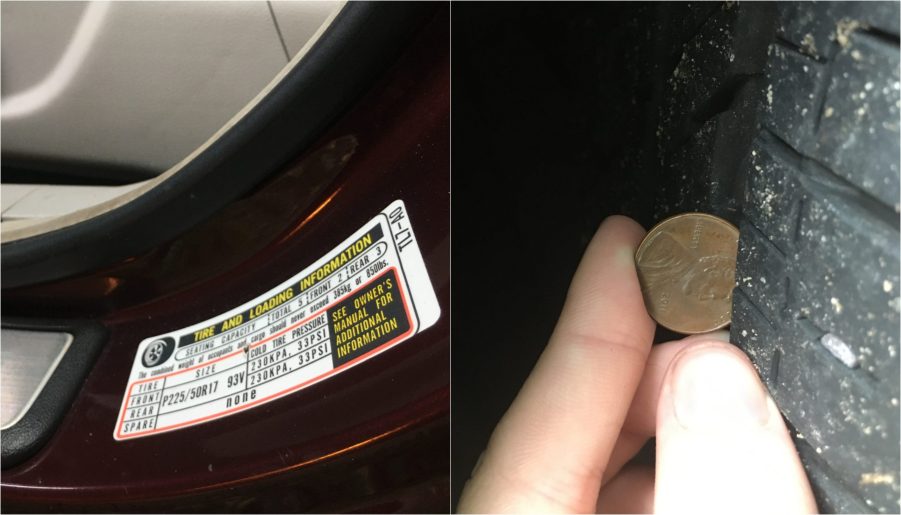
Here’s Everything You Need to Know About Tire Maintenance
There’s an awful lot of steps to properly maintaining your car, and it can be incredibly overwhelming. So to break it down, let’s talk about just one aspect: tire maintenance. You might not think of them much, but truth be told, tires are extremely important. They keep you glued to the asphalt, and are fairly easy to keep tabs on in order to prolong their life and save you money.

Determining the right tire pressure, putting air in them, and checking tread depth
Perhaps one of the easiest parts of automotive maintenance is making sure your tires are properly filled with air. It may also be the cheapest, considering some gas stations offer air pumps free of charge. Though, you can also keep a $20 12-volt air compressor in your car so that, at any point, you can top them off with air. But I’m getting slightly ahead of myself.
If you own a relatively new car, then figuring out how much air you need to put in the tires is simple. Step one, open the driver’s side door. Step two, look for a sticker with all the information on it. You’ll see the recommended pressure in pounds per square inch (or PSI) for both the front and rear.
Now, it’s incredibly important that you fill it to the right amount. Overinflating your tires risks punctures, hinders your car’s handling and causes uneven tire wear. Underinflating, while a decent practice for offroading, also murders your miles per gallon.
From there, filling your tires with an air compressor is a sinch. Unscrew the cap on each rim, screw the air compressor in, push the button, and listen to it whir. Don’t expect to be perfect either. If you’re off by a PSI or two, it’s not going to ruin your car, or even put you at risk. Just get as close as possible.
If you thought filling your tires with air was easy, just wait until you check the tread depth. All you need is a penny, which you simply stick in the rubber of the wheel. Then, look to honest Abe Lincoln. If it looks like he’s getting a haircut, you’re all set. And if he could use a trim, then you may want to consider new ones.
Rotating your tires is an often overlooked aspect of car maintenance

Checking your rubber and changing it when the need arises is important for tire maintenance. But what’s more important, and often missed, is routinely having your tires rotated. It’s important to do this, as it spreads out the wear, allowing them to last longer. After all, you want to hang onto your rubber as long as you (safely) can since new tires are expensive.
You can take your car to any mechanic and they’ll be able to do this for you. In fact, if you go to a dealer, they often rotate your tires every time you get your oil changed. The recommended interval for rotating your tires is every 5,000 to 7,000 miles, which comes up fast if you go on frequent road trips.
And while you can take the car to a mechanic, rotating your tires is a fairly easy job to do on your own. The equipment required get’s a bit expensive, however. You’ll need is a floor jack and four jack stands, a breaker bar, a torque wrench, and sockets that fit your rim’s lug nuts. That’ll run you a couple of hundred dollars, and you don’t want to be a cheapskate when it comes to safety equipment.
How you go about rotating your tires depends on what kind of car you drive. Bridgestone explains that, if it’s a front-wheel-drive car, you’ll perform a forward cross, shifting the front tires to the back, and crossing the back tires to the front. If your car is 4-wheel, all-wheel, or rear-wheel drive, you’ll likely use a rearward cross. And if you drive a light FWD truck, you may use an X pattern, where every tire is crossed.
Be sure to consult your owner’s manual and the internet before rotating tires yourself, or performing any sort of maintenance. And tighten those lug nuts to the manufacturer’s recommended torque spec, which you should also be able to find online.
If your rubber is causing you trouble, there are a few things you can do

Realizing your rubber might be slightly defective while in motion is a scary thought, but take a breath, because there are a couple of ways to diagnose and solve the problem. Two common problems are improperly balanced tires or improperly aligned wheels, both of which can affect your car’s handling. Here’s how to spot and solve each one.
If you notice uneven wear on your tires or feel harsh vibrations while in motion, they may need to be balanced. Determining where you feel the vibrations can help technicians find which ones need to be balanced. If you’ve parked the car for a long period of time, it may also cause flat spots on the tread, which can be solved by balancing the tire. Though, in extreme cases, you may be better off replacing the rubber altogether.
If, however, you notice your car veering off to one side, that might not be a problem caused by your tires. Instead, you’re looking at improper wheel alignment, where the steering wheel isn’t pointed straight when the car is. Other symptoms of improper alignment include vibrations through the steering wheel and tire squealing (when you’re not trying to burn rubber). This is a more expensive repair, but worthwhile if you want to prevent them from wearing out unevenly
Taking care of your tires is one of the many steps in creating a proper maintenance schedule. And maintaining your car is a large chunk of the responsibilities in car ownership. But the more proactive you are, the better of you and your car will be in the long run.


